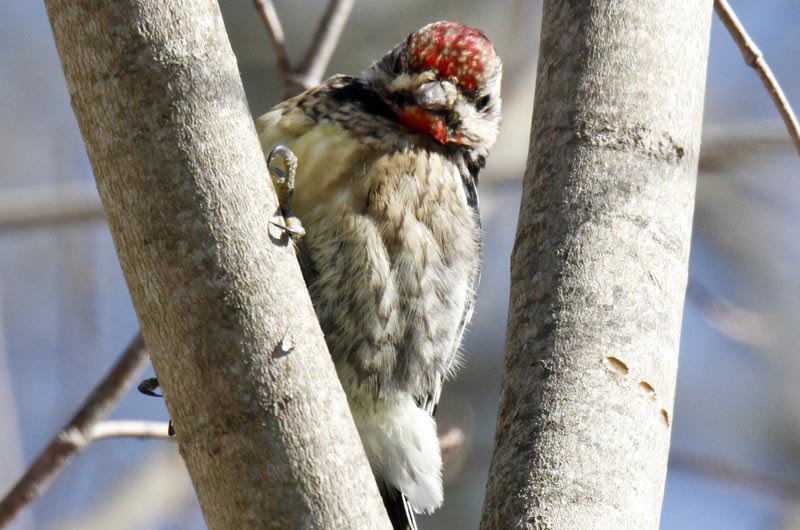Snow and ice make it tough for some of our birds. In this snowy and cold weather, birds may really depend on your feeders for their survival; the food they get from your feeder may be that little bit extra that helps them to survive cold nights, especially when much of their natural food is hidden under the snow. Please do not stop feeding the birds now!
Most of us have noted an increase in the numbers of birds at our feeders. Allan Keith noticed an influx of dark-eyed juncos, including one female Oregon junco with a brown back and flanks and a distinct sooty gray head; this used to be a separate species back in the day when we still called them slate-colored juncos. More and more scientists are once again considering the Oregons to be a separate species.
Penny Uhlendorf and Scott Stephens report that their feeder is as busy as it ever has been this winter. They have the usual birds plus flickers, starlings, robins, one fox sparrow and one male towhee. Happy and Steve Spongberg also have a towhee at their feeder. They also made a curious observation running counter to the theory of increased feeder use; their several tufted titmice have disappeared since the storm on Jan. 26. Where did they go?
Melissa Shilling Gold and Marcia Streicher both observed a dozen robins on Jan. 31. These are overwintering birds and they will be visiting any shrubs and trees that still have fruit on them. They may have to go a little higher in the thickets as the lower fruits are buried in the snow. I have heard a few robins hanging out around my holly tree, which is still (for the moment) loaded with berries. Juniper, sumac and winterberry are other important berry-producing plants.
Unfortunately, not all birds will survive this weather. Pam and Clark Goff found a dead American woodcock at the Chilmark Community Church on Feb. 1. At this time of year these birds are found in the deepest thickets, where they probe the ground with their long beaks. But this is really hard to do when there is a lot of snow on the ground and with the ground frozen in the few places where there is no snow.
Bird Sightings
Happy Spongberg found the lone West Tisbury snow goose on Jan. 16, when it was with about 40 Canada geese in the field next to the West Tisbury Cemetery. And Ginny Jones found the five snows that have been at the Keith Farm for a while.
John Nelson and Jan Rapp observed eight killdeer in the fields of the Keith Farm on Jan. 18, back before the snow when it was a balmy 48.
On Jan. 21, Brigitte Cornand observed two great egrets and a great blue heron hunting along the shores of Tisbury Great Pond near Flat Point Farm. She saw them again on Jan. 26, the first day of the snow. And, in another snow storm (well, sleet and rain) the morning of Feb. 2, she observed them flying past! She did not see them in between the two storms.
During the snows of Jan. 27, Stan and Marie Mercer reported an invasion of about 50 grackles which were so aggressive that they prevented all the other birds from eating the suet and sunflower seeds. The birds they displaced included cardinals, white-breasted nuthatches, tufted titmice, black-capped chickadees, house finches, and most notably, a pair of purple finches. Allan Keith had two grackles show up at his feeder at the beginning of the snows on Jan. 27, and on Feb. 2 that number had swelled to 14. He also has three red-winged blackbirds at his feeders. Meanwhile, the hundreds of red-winged blackbirds that had been hanging out in Pam and Clark Goff’s fields have disappeared. Whose feeders have they moved to? Apparently two of them moved to Stephanie Mashek’s feeder as she reported two of them there.
Bill Wilcox sent a photo of a Baltimore oriole visiting his feeders on Jan. 29. On the 30th, this paler orange individual was at Nancy Dole’s feeder, and she confirms that this bird is much paler than the one she observed prior to the storm.
Lanny McDowell observed a yellow-bellied sapsucker mining the sap from a tree near his house on Jan. 31. He reminds us to keep an eye on the fresh sapsucker holes — the holes are in horizontal rows drilled into the tree trunk — as many other species will take advantage of the flowing sap.
Sharon Simonin has a sharp-shinned hawk harassing her bird feeders.
Speaking of woodpeckers, we have received several reports of a leucistic downy woodpecker prowling around Felix Neck and Major’s Cove. Luanne Johnson is the latest to report this individual, which was at Felix Neck a few months ago. Could it be the same individual leucistic downy that was at Margaret Curtin’s feeder in Vineyard Haven a few years ago?
On Feb. 1, Jeff Bernier visited Menemsha and observed a single female ruddy duck and eight brant, along with the more expected common goldeneyes, horned grebes, red-breasted mergansers, common eiders and common loons. That same day, Allan Keith visited the Head of the Lagoon. He found the common gallinule feeding vigorously in the open water on the Vineyard Haven side of the pond. There also were three American coot and 14 ring-necked ducks there.
There are lots of birds around, so please get out looking for them, and be sure to report your bird sightings to birds@mvgazette.com.
Robert Culbert leads guided birding tours and is an ecological consultant living in Vineyard Haven.





Comments
Comment policy »